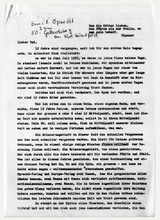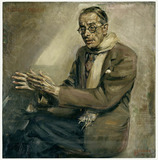Kurt Hirschfeld: speech marking the 50th birthday of publisher Emil Oprecht, typescript (1945)
Theatre director Kurt Hirschfeld used the 50th birthday of publisher Emil Oprecht on 23 September 1945 as an occasion to look back. Hirschfeld’s speech emphasised the many facets of Oprecht’s character, his helpfulness and cosmopolitan outlook, his diverse contributions to political and cultural life.
Kurt Jooss: Note on the ballet Chronica (1939)
Chronica was written in exile in England in spring 1939 and fits in with many of the works of choreographer Kurt Jooss in its examination of power and sovereignty structures.
Kurt Schwitters, Certificate of Registration (1941)
Kurt Schwitters’ flight from Germany to Great Britain unfortunately culminated in the artist’s internment. Schwitters reached Edinburgh with his son on 19 June 1940, shortly after the British government had decided to hold all “enemy aliens” in impromptu detainment camps.
Kurt Schwitters, photograph of Schwitters reading Ursonate (1944)
Kurt Schwitters’ most significant works, according to the artist himself, were his Merzbau installation – a sculpture in his parents’ home in Hanover that spanned several rooms – and the Ursonate, a sound poem comprising three musical movements. While he was forced to abandon his Merzbau construction forever upon his flight from Germany in 1937, Ursonate, a poem he recited countless times from the 1920s onwards, remained part of his repertoire in exile.
Kurt Schwitters: Letter to Helma Schwitters (24 December 1940)
Kurt and Helma Schwitters decided to separate temporarily in 1937, a move that became necessary when the Nazi regime classified Kurt Schwitters’ art as “degenerate”. Kurt travelled with the couple’s son to Norway, while his wife remained in Germany for a period, caring for her sick parents and her mother-in-law, while also organising the shipment of the couple’s furniture and art collection to Norway.
Kurt Schwitters: Letter to Helma Schwitters (30 May 1941)
Kurt Schwitters wrote a series of letters to his wife Helma in Germany from the British internment camp in Douglas on the Isle of Man. The correspondence was subject to the examination of both British and German military authorities.
Kurt Schwitters: Nebel in Djupvasshytta (Fog in Djupvasshytta), 1937
In 1937, Kurt Schwitters took the decision not to return to Germany from his sojourn in Norway. His reasons are still the subject of some speculation today.
Kurt Schwitters: Portrait of Rudolf Olden, painting, 1940
During his period of internment, Kurt Schwitters created 200 to 250 works. He drew and painted his surroundings using the few materials available to him and his interred artist colleagues.
Kurt Schwitters: Portrait of the Sculptor Charoux, 1940
Branded an “enemy alien” upon his arrival in Britain, Kurt Schwitters was held in an Isle of Man internment camp from July 1940 until November 1941 but was still able to continue his work as an artist thanks to the support of camp commander and art enthusiast Captain H. O.
Kurt Schwitters: Relief wall, part of Merz Barn (1947)
For their creator, the artist Kurt Schwitters, the “Merzbauten” (“Merz constructions”) series of abstract installations were of great significance. They not only reflected the artist’s artistic style through their sprawling sculptures, which spanned several rooms – they also endured a similarly tragic fate.











